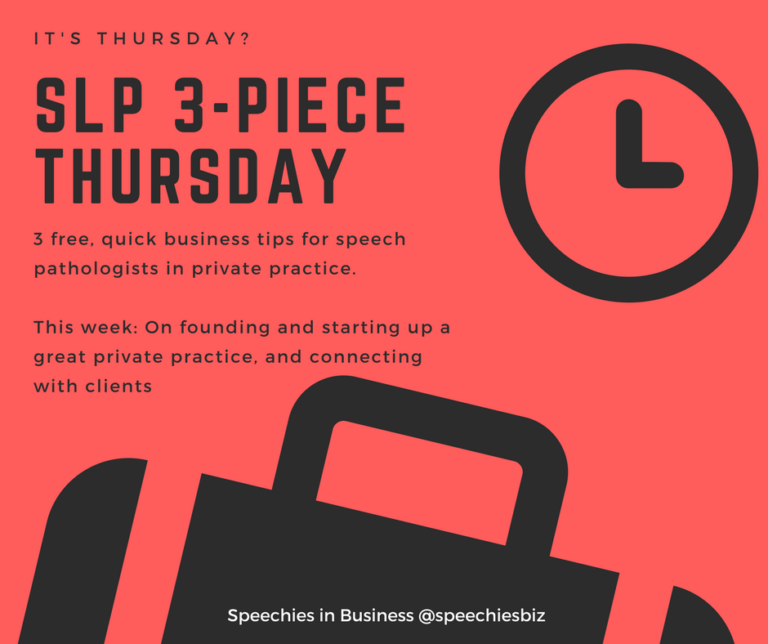Speech pathologists: how to build ethical, profitable, high quality private practices that outlast us
Over the break, while couch-potato gazing at the cricket, I gave some thought to long-term, sustainable business models for private speech pathology practices. Specifically, mine!
When you start out, almost anything you read about launching a small business will at some point hit you with a frightening stat or two, e.g., that 80% of small businesses fail in the first 5 years. I’m not aware of any specific stats on speech pathology practices, but I’d expect that figure to be about right.
Why?
Lots of us start out in private practice because we want the flexibility and independence of running our own show. We are confident (or confident enough!) in our technical skills as speech pathologists and think we can do things better that where we were before to help clients with their communication or swallowing needs.
But knowing how to be a great speech pathologist is not the same thing as knowing how to run a business. To run a business, you need business knowledge and systems.
Business infancy
When I started my private practice, I was pretty much my clinic, and my clinic was me. My wife and I did all the work ourselves. But as we got busier, and our case load grew in volume and complexity, the work became harder to handle. At one stage, we were working seven days a week – often 12 hours a day – to ensure we kept our therapy service quality high. But, even working 60 hours a week to ensure our clients got the best possible service, “non-client” things started to slide. We just didn’t have the time or energy to attend to all the back office stuff.
Business adolescence
Eventually, we got some help. Initially, with some of the back office tasks we despised (e.g. book-keeping), and then by hiring high-quality staff to help deliver our services. The danger with this “teenager” stage of business is ensuring your quality remains high even though you are not delivering every assessment and therapy session yourself. This was (and remains) hard for a control freak like me! But I knew that my practice would fail in the long run if I couldn’t grow it to a stage beyond my ability to do and control everything myself.
Sometimes during this phase, I felt like retreating back to the comforts of the one-person practice. But then I remembered how awful it felt to be overloaded with work, turning clients in need away as my waiting list ballooned.
Planting seeds for growth at the outset
Successful businesses think about the future. Ideally – in the long run – you want your practice to work even when you’re not there. To achieve this, you need to think like a business-person and plan how your business will develop as it grows. So I looked in the mirror and asked myself:
- What do you care about the most?
- Why is your practice an opportunity worth pursuing? Is it aligned with what you care about the most?
- How do you want to live?
- How much money do you want (or need)?
- How much freedom from working at the coalface do you want?
- What sets your business apart?
- How will you get clients?
- What type of clients will you help?
- How will you deliver your services?
(If interested, you can read more about our start-up philosophy here.)
I then developed a one-page business plan with my purpose front and centre, and my break-even point highlighted in pink.
Even though I didn’t want to, I needed to think like an “entrepreneur”. Now, I know that word has some colourful connotations, and not everyone in private practice is comfortable thinking of their practice as a business. But, as I’ve said before, I think it’s perfectly possible to be both ethical and profitable. In my previous career as a finance lawyer, I observed that it was often the well-meaning, but unprofitable and ill-managed, businesses that were vulnerable to major systems failures and pressures to cut corners at the expense of their clients.
Get out of your own way!
Here’s a quote I love from Michael Gerber:
“The problem isn’t your business; it never has been. The problem is you!”
That was so true with us! We needed to realise that many of our early struggles were caused by the confusion and tension of trying to wear multiple hats at the same time. Every day, in the clinic, I was part:
- (mostly) speech pathologist, focusing on improving my technical skills to help clients with the latest, evidence-based therapies;
- manager, focusing on boring (but essential) business and compliance systems, organisation strategies, and finding ways of doing things more efficiently; and
- entrepreneur, creating new services and products, dreaming up new ways of doing things, looking for opportunities to grow and to connect with others.
The (ongoing) problem is figuring out how much energy to devote to each role at any given time.
How to build a business that lasts
Another top tip I learned from Michael Gerber:
“Pretend that the business you own…is the prototype, or will be the prototype, for 5,000 just more like it!”
Now, as an, ahem, former McDonald’s crew member, I’m not a huge fan of the franchise model for allied health. But I loved the idea of designing my clinic to be systems-dependent rather than owner-dependent. Documenting your key systems:
- forces you to write down the (sometimes conflicting) contents of your head. I discovered scores of duplicated efforts, wastage and service gaps in my systems just by writing them down;
- allows others to understand and work to your standards without being micromanaged;
- ensures people are accountable for their outcomes; and
- increases the predictability of your service quality.
When we started our clinic, we set up systems that we hoped would grow with the business – even if they seemed ridiculously over-engineered for the client flow at first. I even signed my own Code of Conduct.
Why we had an organisation chart for two people
Even when we were (literally) a Mum-and-Dad business, we wrote down all the roles in our practice (e.g. clinical, operations, marketing, Human Resources, accounting, finance, etc.), and then assigned them – initially all to ourselves, but, as the business grew, to our staff and partners. This helped us stay clear on who was accountable for what and when, even (especially) when we were doing everything.
Human Resources: hire people who are smarter than you
When we hire someone to help us, as an employee, contractor or service provider, we test candidates against the standards we’ve set for ourselves in the position. We look to hire people who are at least as good (preferably better) than us at doing the job. We also try to make sure staff and partners understand the meaning of the work they’re doing and how it fits into our purpose and plan.
Marketing: it’s all about the clients
Our marketing plan is simple: doing our job as well as we can. We don’t rely on advertising. We focus all our efforts on solving real-life problems for people who need speech pathology. That’s why we publish free blogs, books and resources, and address frequently asked questions. That’s why we do community and school talks. We try, consistently, to help people who need speech pathology services find the answers they need.
Don’t lose sight of why your business exists
The business development process – the design of business models and systems – never ends, especially in a time of great change for speech pathologists. When we look at our medium-to-long term business goals, we see a complex, but easy-to-run, set of systems and processes that all work together to support our primary aim: helping adults and children to speak for themselves.
Principal source: Michael E. Gerber, The E-Myth Revisited: Why most small businesses don’t work and what to to about it. Kindle edition via here.
Image: https://tinyurl.com/h2tx26v








